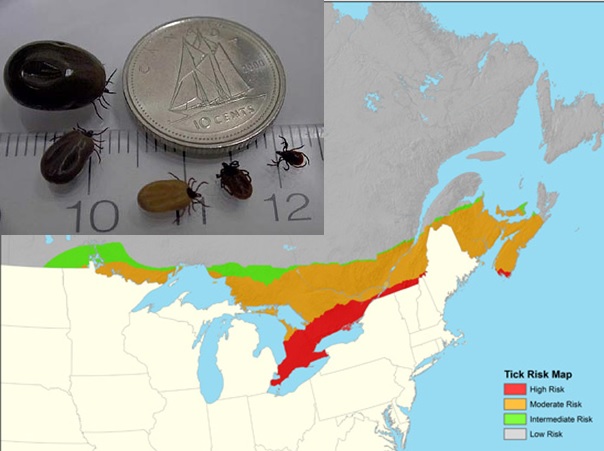
The weather has finally improved and Oakville residents are happily shedding their winter jackets and boots and re-acquainting themselves, and their pets, with the great outdoors. While many know the outdoor environment potentially exposes our pets to parasites like fleas and intestinal worms, vets in Oakville are reminding residents of the risk of a new creepy crawly in the area – ticks!
Here are some important facts:
– Ticks are a growing threat in Ontario
– Ticks can transmit Lyme Disease
– Your dog is at a higher risk of tick exposure if you walk along trails or areas with tall grasses
– There are monthly topical medications and other products that can help prevent ticks from attaching to dogs
Once a rare finding in this area, ticks are rapidly growing in populations and spreading across Southern and Eastern Ontario. An recent study estimated that the area populated with ticks in Canada will expand by an average of 46 kilometers per year. The map above is provided by Health Canada and shows a large area that will be at high risk of exposure to Lyme Disease over the next 10 years.
There are two major types of ticks we currently see in Ontario. One is the American dog tick (Dermacentor variabilis), which is capable of spreading diseases but rarely found to do so in this area. The other is the deer tick (Ixodes scapularis), which is the carrier of Lyme Disease.
Currently less than 10% of deer ticks in this area carry Borrelia burgdorferi, the bacteria which causes Lyme Disease. However, as the tick population establishes itself, the proportion of ticks carrying this bacteria will increase. In areas where these ticks have been established for many years, typically 60% will be carriers of Lyme Disease!
Ticks can transmit Lyme Disease to both dogs and people by attaching to and remaining on their host for at least 36 hours. Ticks are not always readily visible after attaching to a dog, so it is common for them to remain on dogs for this long.
Signs of Lyme Disease in dogs include fever, swollen lymph nodes, and swollen and sore joints. In some cases, kidney damage occurs and if this happens, dogs may vomit, stop eating, and become lethargic. If you suspect your pet is infected with Lyme Disease, a blood test can be performed to identify previous exposure to the bacteria and trial treatment will often be recommended.
Ticks can be found anywhere, but dogs that walk along trails or other areas with tall grasses are at a higher risk of getting exposed to a tick. Dogs and cats should always be examined for ticks after being outside, which can come in various sizes (see the image above). If found, ticks should be removed carefully to ensure the entire head of the tick is removed. Please contact your veterinarian for advice on or assistance with tick removal.
Ticks can be prevented with the use of monthly topical preventative products or tick collars. You can further protect your dog by administering a vaccination effective against Lyme Disease. Please contact your veterinarian for advice on tick protection for your family pet!



